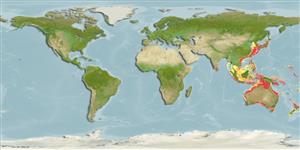Environment: milieu / climate zone / depth range / distribution range
Écologie
marin; saumâtre démersal; profondeur ? - 150 m (Ref. 9563). Subtropical
Indo-West Pacific: most coasts of Australia.
Taille / Poids / Âge
Maturity: Lm ? range ? - ? cm
Max length : 34.0 cm TL mâle / non sexé; (Ref. 3132); common length : 22.5 cm SL mâle / non sexé; (Ref. 9774); poids max. publié: 1.5 kg (Ref. 3132)
Épines dorsales (Total) : 0; Rayons mous dorsaux (Total) : 65 - 74; Épines anales: 0; Rayons mous anaux: 51 - 60. Body brownish, 2 conspicuous ocelli above and below lateral line and 1 or 2 ocelli on posterior part of straight section of lateral line, a dark blotch at junction of straight and curved portions of lateral line. Upper profile of head distinctly notched in front of upper eye. A line connecting base of first dorsal-fin ray and posterior nostril on eyed side crosses maxilla. Origin of dorsal fin slightly before anterior margin of upper eye and just above or behind posterior nostril on blind side. Pectoral fin on ocular side with 11-12 soft rays (Ref 9774).
Occurs in estuaries and offshore over sand or mud bottoms (Ref. 9563). Feeds on various benthic animals (Ref. 9774). Marketed fresh (Ref. 9774) and is considered an excellent food fish.
Life cycle and mating behavior
Maturities | Reproduction | Spawnings | Egg(s) | Fecundities | Larves
Distinct pairing (Ref. 205).
Robins, C.R., R.M. Bailey, C.E. Bond, J.R. Brooker, E.A. Lachner, R.N. Lea and W.B. Scott, 1991. World fishes important to North Americans. Exclusive of species from the continental waters of the United States and Canada. Am. Fish. Soc. Spec. Publ. (21):243 p. (Ref. 4537)
Statut dans la liste rouge de l'IUCN (Ref. 130435)
Menace pour l'homme
Harmless
Utilisations par l'homme
Pêcheries: commercial
Outils
Articles particuliers
Télécharger en XML
Sources Internet
Estimates based on models
Preferred temperature (Ref.
123201): 15.2 - 28.7, mean 25 °C (based on 964 cells).
Phylogenetic diversity index (Ref.
82804): PD
50 = 0.5000 [Uniqueness, from 0.5 = low to 2.0 = high].
Bayesian length-weight: a=0.00741 (0.00343 - 0.01604), b=3.17 (3.00 - 3.34), in cm total length, based on LWR estimates for this Genus-body shape (Ref.
93245).
Niveau trophique (Ref.
69278): 3.5 ±0.37 se; based on food items.
Résilience (Ref.
120179): Haut, temps minimum de doublement de population inférieur à 15 mois (Preliminary K or Fecundity.).
Fishing Vulnerability (Ref.
59153): Low vulnerability (24 of 100).
Nutrients (Ref.
124155): Calcium = 96.9 [45.9, 222.1] mg/100g; Iron = 1 [1, 2] mg/100g; Protein = 17.6 [15.6, 19.6] %; Omega3 = 0.235 [0.125, 0.434] g/100g; Selenium = 29.5 [14.7, 60.8] μg/100g; VitaminA = 7.58 [2.15, 27.85] μg/100g; Zinc = 0.75 [0.51, 1.09] mg/100g (wet weight);
